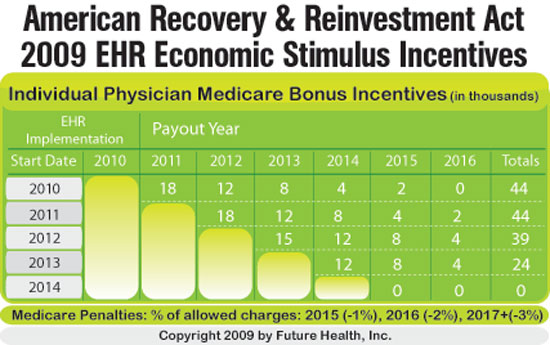In all my recent meetings with government officials, including several trips to Washington, D.C., and participation in numerous reform initiatives, like the regional White House Forum on Health Care Reform, major buzz surrounds the electronic health records portion of the economic stimulus plan. To date, much has been discussed about the American Recovery and Reinvestment Act (ARRA) of 2009 and its impact on healthcare and, with more than $19 billion of the economic stimulus package dedicated to the implementation of electronic health records across the nation, the attention is warranted. Though the rules and standards related to implementation have not been fully established, some key elements have been confirmed that influence decision-making today.
How to get $44,000 for your EHR investment
Let me first emphasize that the Electronic Health Record (EHR) package is directed at physicians, and doctors of chiropractic are included because the ARRA of 2009 adopted the definition for physicians for this program from the Social Security code. This is an important note, as not all healthcare professionals will be eligible for incentive payments, but chiropractic physicians are an approved group.
In order to fully understand the incentive payment requirements, you must ask yourself two integral questions to determine eligibility. Do you have a qualified EHR product? And are you using it meaningfully in practice?
To be qualified, the EHR system must have the capacity to handle patient demographics and clinical health information. It must also have clinic management capabilities, as outlined by the entity that certifies qualified EHR’s. Only certified EHR’s will be considered for incentive payments, and the certification body has yet to be named. However, most insiders predict that the Certification Commission for Healthcare Information Technology (CCHIT) will be selected, as it is the only entity currently approved by Medicare for EHR certification.
So, if you have a qualified EHR, are you using it meaningfully? “Meaningful use” is defined by three key measures: (1) Connectivity to health information exchanges (HIE’s) and other EHR’s; (2) Regular reporting of quality measures to the Centers for Medicare Services (CMS), including outcome assessment scores and pain assessments; and (3) e-prescribing capability (Note: because chiropractic physicians do not have prescribing privileges, it is unknown whether this will remain a requirement for DC’s.). The framework that has been introduced suggests that reporting quality measures to CMS will likely be managed by PQRI, the Physicians’ Quality Reporting Initiative, a standardized mechanism that already exists. More rules regarding reporting requirements are expected to come at a later date.

Once you answer “yes” to the above questions, as much as $44,000 is available as a post-adoption incentive for implementing EHR. What’s more, for clinics with multiple physicians, each physician can qualify for an incentive payment, as long as a qualified system is being used and each physician is using it meaningfully, as the terms outline.
To qualify for the full incentive payment of $44,000, your EHR system has to meet the aforementioned qualifications, no later than 2010, to begin earning incentive payments in 2011. If you’ve already adopted a system that meets these guidelines, then you automatically qualify for the incentive payment.
And, while we know that the Department of Health and Human Services and the Center for Medicare Services will be involved, their specific roles are still being evaluated with regard to reporting and eligibility requirements for doctors participating in the incentive program. For example, minimum billing thresholds, such as an annual $25,000 in covered services to CMS, are being considered in order to be eligible for the incentive payments. However, there is some discussion on consideration for proportionate payments if the threshold is not met. So, if you average 16 Medicare patient visits a week, you would likely qualify.
The chart included with this column outlines the incentive payment schedule in simple terms.
The ideal timeline for implementation
Typically, it takes 90 days to six months to plan, train, and implement the new EHR system. PQRI currently states that you have to report on 80 percent of your patients. Assuming PQRI is a requirement for demonstrating meaningful use, it stands to reason that you would have to use the system for the better part of 2010 to begin receiving your first incentive payment in 2011.
Implement in 2009, use the system in 2010, and begin receiving incentive payments through Medicare in 2011. If you opt not to transition to an electronic health record system, you will be penalized beginning in 2015 through 2018. These penalties will be assessed against your normal reimbursement for services from Medicare.
So far, only 15 to 20 percent of DC’s have moved to EHR. With enormous financial incentives to support the move, there is no longer an excuse to wait. There are just too many good reasons to adopt!
 Dr. Steven J. Kraus is CEO of Future Health, Inc., a company that partners with chiropractors to deliver a comprehensive clinic management solution, including fully-integrated EHR. Dr. Kraus is a recognized expert in building successful clinics, having developed and sold 18 practices of his own and provided strategic consulting services to more than 400 healthcare businesses. He offers leadership to numerous industry associations and currently serves as the Chairman of the Iowa Board of Chiropractic. Contact Dr. Kraus at [email protected] for more information.
Dr. Steven J. Kraus is CEO of Future Health, Inc., a company that partners with chiropractors to deliver a comprehensive clinic management solution, including fully-integrated EHR. Dr. Kraus is a recognized expert in building successful clinics, having developed and sold 18 practices of his own and provided strategic consulting services to more than 400 healthcare businesses. He offers leadership to numerous industry associations and currently serves as the Chairman of the Iowa Board of Chiropractic. Contact Dr. Kraus at [email protected] for more information.
